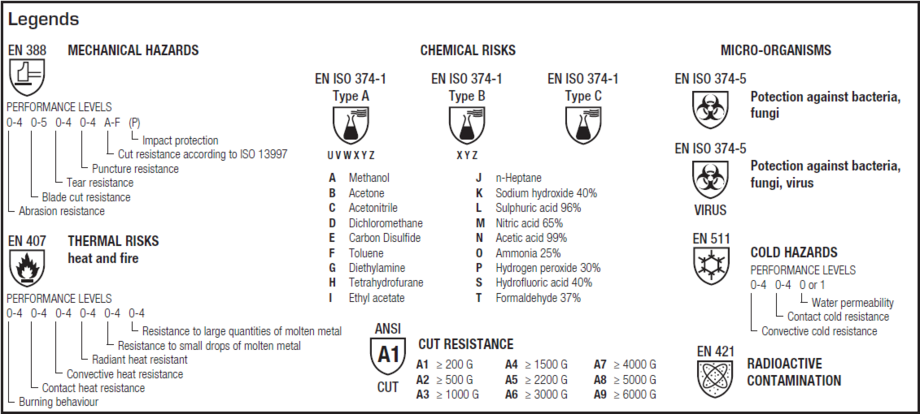About norms
European legislation and standards
The directives concerning Personal Protective Equipment have the objective to harmonize the legislations of the Member States and to establish the requirements to which the products and their users must comply.
The European standards define the technical specifications required to meet these requirements.
Mapa Professional would like to take this opportunity to explain these provisions to you.
The 89/656/CEE (Use) directive describes the requirements to which the employers must fulfil for the supply and the use of PPE by their employees.
The 89/686/CEE (Design) directive describes the essential requirements for selling protective gloves on the European Market.
The whole Mapa Professional range is CE certified in conformity with these essential requirements, and their products are CE-marked
CE certification categories

Category 1: The manufacturer is responsible for the conformity of its products, with respect to the essential requirements of the Directive
Category 2: Certificate of conformity obtained from a notified body
Category 3: Certificate of conformity and regular production inspections on the manufacturer’s premises by the notified bodies
European pictograms

Regulations relative to food contact
An European regulation
To find out more about food handling, first we need to look at European legislation. The principal European regulation (1935/2004) identifies and sets certain outlines but also states that more specific measures can be adopted by member states. These steps can be completed by national steps.
This regulation (1935/2004) applies to any object that is intended to come into contact with food.
The regulation 1935/2004 :
- Defines general requirements. Items designed according to good manufacturing practices to ensure that foodstuffs are not contaminated with any constituents in such quantities as might be dangerous to human health or modify the composition of the foodstuff.
- And identifies the materials and items for which specific measures can be adopted:
-
Limit for overall or specific contamination
- Limitations of levels of certain substances
- List of authorised ingredients
- It outlines labelling conditions: symbol glass&fork and/or ‘For food contact’. Item labels should in no circumstance misinform the prescriber or user.
The declaration of food compliance
Established by the manufacturer based on tests carried out without mandatory third party checks. Please note that this point is furthermore not checked when the AET (certificate obtained at the end of the certification process) is issued.
Great care must therefore be taken regarding the interpretation of this image.
Specific European Directives (82/711 and 85/572)
Establish the fundamental guidelines and define the simulants to be used to check contamination of materials based on the type of foodstuff.
3 important points:
- Materials intended to come into contact with all types of foodstuff must be tested using the following 3 simulants: 3% acetic acid, 10% ethanol and refined olive oil.
- Materials intended to come into contact with specific foodstuffs must be tested with one or two of the three simulants (see table included in directive 85/572). Occasionally distilled water is used instead of acid.
- Regarding the olive oil simulant: to account for the fact that contamination of certain fats can be far less than that of pure olive oil, the amount measured can be divided by a reduction factor of between 1 and 5, depending on the foodstuff. 5 food grades for fats are outlined as a result.
Summary of legal constraints
Responsibility of agro-food producer: they alone are legally liable for the sanitary quality of their products.
Highly specific regulatory tests: All components of the glove must firstly feature in the positive list.
The glove must then be tested for overall and specific migration depending on the type of foodstuff handled.
IMPORTANT: A glove can be approved for the handling of certain foodstuffs and not others.
Food grade declarations for gloves are subject to strict regulations: in order for a glove to be labelled with only a symbol glass&fork, it must have passed all tests for all types of foodstuff. This symbol can however always be accompanied by clear, strict usage restrictions.
IMPORTANT: No law obliges agro-food producers to use gloves with this symbol. However, they must use gloves which have passed standardised tests appropriate to the foodstuff handled, so as to ensure that they do not risk contaminating their products.
Certification categories IFS and BRC
As well as the international legislations and standards, (ISO 22000), the French, German and Italian federations of sales and distribution have developed a certification category applying above all to food safety: IFS (International Featured Standard for Food).
The aim of the IFS 5 (5th, current version) is to aid producers in ensuring that there is no contamination during their production, whilst taking into account their actual working conditions.
The BRC (British Retail Consortium) has developed a similar certification category (Global Standard for Food Safety) for the UK.
The IFS and the BRC are frequently revised in order to consistently improve food safety.
An annual audit (IFS 5 / BRC) is imposed by major retail chains to approve their suppliers.
- Mandatory and applying to every production site: its main application concerns anything which could come into contact with foodstuffs during the manufacturing process - increasingly this can mean gloves.
- Based on continuous improvement: If manufacturers are not fully up to standard at the first audit, auditors commit to improving the sites over
the years to come.
As the symbol glass&fork is not sufficiently precise, and its application is not checked by an external independent organisation, the results of appropriate tests, for both foodstuffs and working conditions, are required.
The role of Mapa Professional
- Offer a range of specific gloves which comply with legal requirements
Each time the symbol glass&fork is displayed, all restrictions are clearly indicated strictly according to the European regulations which apply to materials and items in contact with foodstuffs.
- See Directive 85/572
Providing a precise table of food contact results for the 88 classes of foodstuffs in the directive.
More information on this link : click here
- Supply a personalised solution
Applications and uses of a glove can differ from site to site. Mapa Professional adapt their product to each situation.
CATEGORY 1: regulated test conditions (2h, 40°C) represent working conditions.
- If the glove is approved as food grade according to the food grade table for the foodstuff(s) handled, Mapa Professional automatically provides the food grade certificate (Mapa Professional or client-specific certificate).
- If the glove is not approved as food grade according to the food grade table for the foodstuff(s) handled, then it is considered to be incompatible and Mapa Professional offers a different type of glove.
CATEGORY 2: regulated test conditions (2h, 40°C) do not represent working conditions
Mapa Professional defines and carries out appropriate tests compliant with the leading regulation 1935/2004.
In both cases, Mapa Professional responds fully to quality and safety systems for foodstuffs (ISO 22000, HACCP).